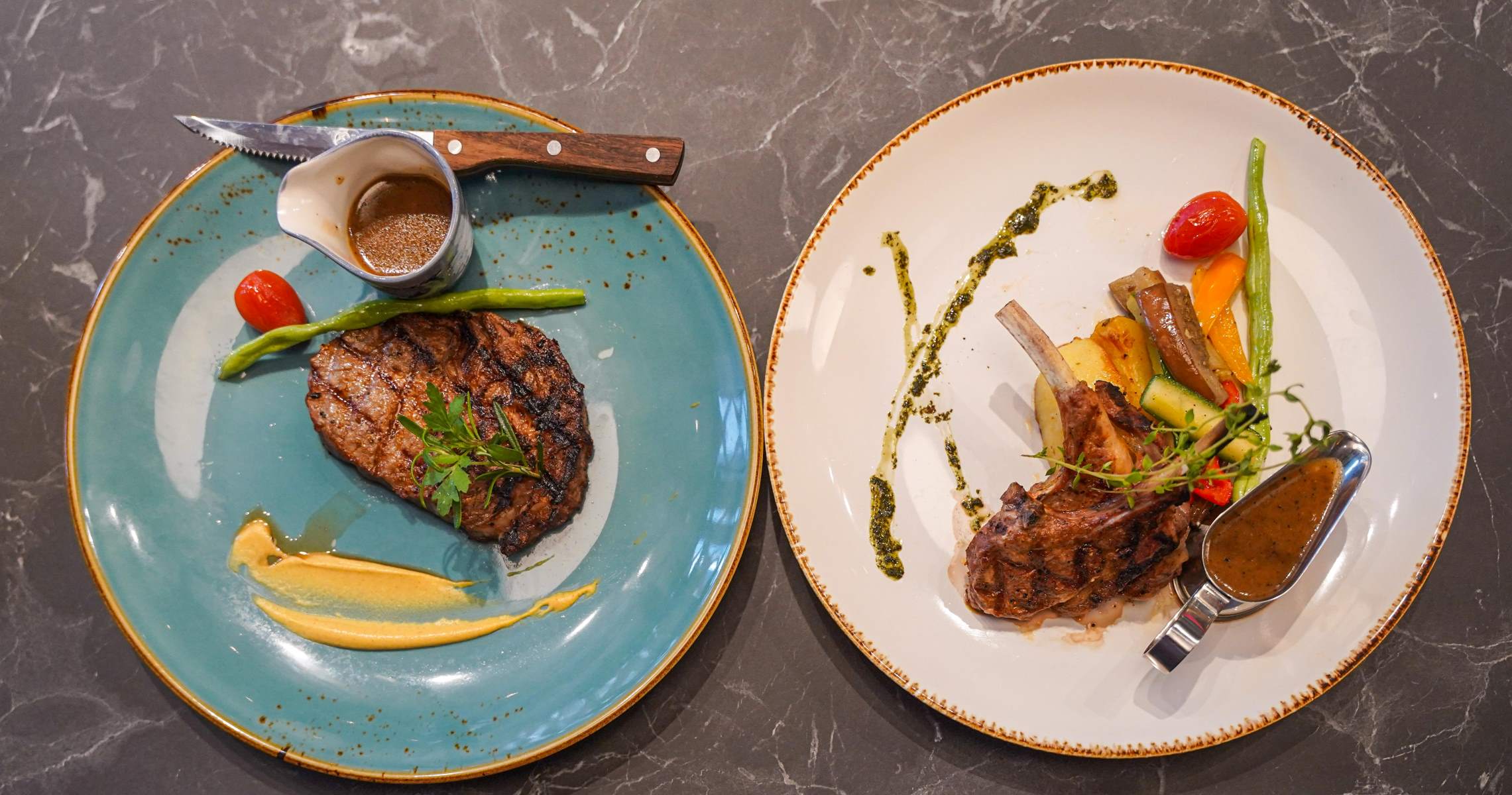Home>Food and Cooking>Top 10 Tantalizing Foods That Start With The Letter T


Food and Cooking
Top 10 Tantalizing Foods That Start With The Letter T
Published: January 28, 2024
Discover the top 10 tantalizing foods that start with the letter T! From tacos to tamales, explore delicious T-starting dishes and recipes. Perfect for food and cooking enthusiasts.
(Many of the links in this article redirect to a specific reviewed product. Your purchase of these products through affiliate links helps to generate commission for Regretless.com, at no extra cost. Learn more)
Tacos
Tacos are a beloved Mexican dish that has gained immense popularity worldwide. These delightful treats consist of a corn or wheat tortilla filled with a variety of savory ingredients, offering a burst of flavors and textures in every bite. The versatility of tacos allows for endless creativity, making them a favorite choice for both home cooks and professional chefs.
A Brief History
Tacos have a rich history dating back to the 18th century in the silver mines of Mexico. The word "taco" actually referred to the small explosives workers used to extract the ore. It wasn't until the 19th century that the term evolved to describe the delicious food we know today.
The Art of Crafting Tacos
The beauty of tacos lies in their simplicity and adaptability. The base of a taco is the tortilla, which can be soft or hard, corn or flour, providing a neutral canvas for an array of fillings. From seasoned meats such as carne asada (grilled beef) and al pastor (marinated pork) to flavorful seafood like grilled shrimp or battered fish, the protein options are diverse and enticing.
Toppings play a crucial role in enhancing the taco experience. Freshly chopped onions, vibrant cilantro, tangy lime juice, and spicy salsas add layers of complexity to the flavor profile. For those who appreciate a touch of creaminess, guacamole or sour cream can provide a cool contrast to the heat of the fillings.
Regional Variations
Each region in Mexico has its own take on tacos, showcasing the country's diverse culinary heritage. In the Yucatán Peninsula, cochinita pibil, a slow-roasted pork dish marinated in achiote paste, is a staple filling for tacos. In Baja California, fish tacos reign supreme, featuring crispy battered fish topped with cabbage slaw and creamy sauces.
Tacos Beyond Borders
The global appeal of tacos has led to innovative interpretations around the world. In the United States, the fusion of Mexican and American cuisines has given rise to unique creations such as the "taco salad" and "taco pizza." Furthermore, vegetarian and vegan versions have gained traction, with fillings like grilled portobello mushrooms or seasoned tofu, appealing to a wider audience.
In Summary
Tacos are a culinary marvel that continues to captivate food enthusiasts with their endless possibilities. Whether enjoyed at a street-side taqueria in Mexico or a trendy urban eatery, the humble taco has proven its ability to bring people together through the shared love of good food.
Tiramisu
Tiramisu, with its luscious layers of coffee-soaked ladyfingers and creamy mascarpone, is a timeless Italian dessert that has earned a place of honor on menus around the world. Its name, which translates to "pick me up" or "cheer me up" in Italian, perfectly encapsulates the mood-lifting experience that this delectable treat offers.
A Decadent History
The origins of tiramisu are shrouded in culinary lore, adding an air of mystique to its allure. One popular narrative traces its creation to the Veneto region in northern Italy during the 1960s. It is said to have been born in the charming city of Treviso, where a talented pastry chef crafted the first rendition of this now-iconic dessert. Another account attributes its invention to the bustling city of Siena, claiming that it was a favorite among the noble elite.
The Art of Crafting Tiramisu
The beauty of tiramisu lies in its elegant simplicity. The foundational elements of this indulgent dessert include delicate ladyfinger biscuits, robust espresso or coffee, and velvety mascarpone cheese. The ladyfingers are delicately dipped in the coffee, allowing them to absorb the rich flavors while maintaining a tender texture. The mascarpone, combined with eggs and sugar, creates a smooth and luxurious cream that envelops the coffee-infused ladyfingers.
Variations and Innovations
While the classic recipe remains timeless, creative variations have emerged to cater to diverse palates. Some renditions incorporate elements like rum or Marsala wine, infusing the dessert with nuanced layers of flavor. Additionally, inventive twists such as adding chocolate shavings, fruit compotes, or caramel drizzles provide delightful contrasts and elevate the dessert to new heights.
Tiramisu Around the Globe
The global appeal of tiramisu has propelled it into the spotlight of international cuisine. From elegant fine-dining establishments to cozy neighborhood cafes, this beloved dessert transcends cultural boundaries and delights dessert enthusiasts worldwide. Its decadent yet balanced flavors make it a perfect finale to a memorable meal, and its elegant presentation adds a touch of sophistication to any dining experience.
A Timeless Delight
Tiramisu's enduring popularity is a testament to its irresistible charm and exquisite taste. Whether enjoyed in a bustling Italian trattoria or savored in the comfort of one's home, this iconic dessert continues to captivate hearts and palates with its timeless allure.
Tater Tots
Tater tots, those crispy, bite-sized nuggets of golden goodness, hold a special place in the hearts of food enthusiasts of all ages. These beloved potato treats, often associated with nostalgic memories and comforting meals, have secured their spot as a quintessential side dish and snack option.
The journey of tater tots can be traced back to the 1950s when they were first introduced by the Ore-Ida company. These ingenious creations were born out of a desire to minimize food waste by repurposing leftover slivers of cut potatoes. The idea was to transform these potato remnants into a delightful and convenient snack that would captivate consumers with its irresistible appeal.
Crafting tater tots involves a meticulous process that begins with finely shredding potatoes to achieve the ideal texture. The shredded potatoes are then seasoned with a blend of spices to infuse them with savory notes, adding depth to every bite. The seasoned potatoes are carefully shaped into small cylinders and then subjected to a precise cooking method that results in a crispy exterior while maintaining a fluffy, tender interior.
Tater tots have become a staple in the realm of comfort foods, offering a satisfying crunch with each bite. Their versatility allows them to complement a wide range of dishes, serving as a delightful accompaniment to burgers, sandwiches, and other main courses. Additionally, tater tots have found their way into creative recipes, such as loaded tater tot nachos and tater tot waffles, showcasing their adaptability and culinary appeal.
The appeal of tater tots extends beyond their delightful taste and texture; they evoke a sense of nostalgia and evoke cherished memories of carefree moments. Whether enjoyed as a side dish at a family barbecue or as a late-night snack during casual gatherings, tater tots have a remarkable ability to bring people together and infuse a sense of joy into any occasion.
In the realm of culinary delights, tater tots stand as a testament to the transformative power of creativity and resourcefulness. Their enduring popularity and timeless charm continue to make them a cherished indulgence for food enthusiasts of all generations.
Read more: Top Cities That Start With The Letter “D”
Tempura
Tempura, a beloved Japanese culinary treasure, embodies a delicate balance of crispy perfection and tender succulence. This iconic dish, consisting of lightly battered and deep-fried seafood, vegetables, and even certain fruits, has captivated food enthusiasts around the globe with its exquisite simplicity and unparalleled flavor.
The art of crafting tempura is a testament to the precision and finesse of Japanese culinary tradition. The batter, known as "tenpura-ko," is meticulously prepared to achieve a light and airy texture that envelops the ingredients without overwhelming them. The key lies in maintaining a delicate balance between the ingredients, typically a combination of wheat flour, egg, and ice-cold water, ensuring that the batter remains light and crisp during the frying process.
One of the defining characteristics of tempura is the emphasis on fresh, high-quality ingredients. From plump prawns to delicate fish fillets and an array of vibrant vegetables such as sweet potatoes, eggplant, and shiitake mushrooms, each component is carefully selected to showcase its natural flavors and textures. The ingredients are delicately coated in the batter just before being gently lowered into hot oil, where they undergo a brief and precise frying process.
The cooking method itself is an art form, as the skilled tempura chef orchestrates a symphony of timing and temperature control to achieve the perfect balance of golden crispness and tender juiciness. The result is a visual and gustatory masterpiece, with each bite offering a harmonious blend of textures and flavors that elevate the dining experience to new heights.
Tempura is often accompanied by a dipping sauce, typically a blend of dashi, soy sauce, and mirin, adding a savory umami dimension that complements the lightness of the tempura. Additionally, a sprinkle of grated daikon radish or a touch of citrusy yuzu may be provided to enhance the overall sensory experience.
The global popularity of tempura has led to innovative interpretations and creative fusions, as chefs around the world infuse their own culinary influences into this timeless dish. From tempura-battered avocado slices to unique variations featuring unexpected ingredients, the allure of tempura continues to evolve while remaining rooted in its rich culinary heritage.
In essence, tempura stands as a testament to the artistry and precision of Japanese cuisine, captivating palates with its exquisite simplicity and unparalleled depth of flavor. Whether enjoyed as a standalone dish or as part of a multi-course dining experience, tempura continues to enchant and inspire, inviting diners into a world of culinary elegance and sensory delight.
Tom Yum Soup
Tom Yum Soup, a revered culinary gem hailing from Thailand, embodies a harmonious fusion of vibrant flavors and aromatic spices. This iconic soup, known for its tantalizing blend of sour, spicy, and savory notes, has earned a revered status in the realm of global gastronomy.
The art of crafting Tom Yum Soup is a testament to the intricate balance of ingredients and the meticulous layering of flavors. The base of the soup typically features a fragrant broth infused with lemongrass, galangal, kaffir lime leaves, and chili peppers, creating a symphony of citrusy, herbal, and fiery undertones. These elements come together to form a robust foundation that sets the stage for the diverse array of ingredients that define this beloved dish.
One of the defining characteristics of Tom Yum Soup is its versatility, allowing for a myriad of variations to suit different preferences and dietary inclinations. The soup often features a combination of succulent shrimp, tender chicken, or hearty mushrooms, each contributing its unique texture and taste to the overall ensemble. Additionally, the inclusion of fresh tomatoes, fragrant cilantro, and a splash of lime juice adds a refreshing brightness that elevates the soup to a realm of sensory delight.
The allure of Tom Yum Soup extends beyond its remarkable flavor profile; it embodies a rich cultural heritage and a deep connection to the culinary traditions of Thailand. Often served as a comforting and invigorating dish, it holds a special place in the hearts of locals and visitors alike, offering a glimpse into the culinary tapestry of the region.
The global popularity of Tom Yum Soup has led to innovative interpretations and creative fusions, as chefs around the world infuse their own culinary influences into this timeless dish. From vegetarian renditions featuring tofu and crisp vegetables to contemporary adaptations that incorporate unconventional ingredients, the allure of Tom Yum Soup continues to evolve while remaining rooted in its rich culinary heritage.
In essence, Tom Yum Soup stands as a testament to the artistry and complexity of Thai cuisine, captivating palates with its vibrant flavors and aromatic allure. Whether enjoyed as a comforting bowl on a chilly evening or as a refreshing indulgence on a warm day, Tom Yum Soup continues to enchant and inspire, inviting diners into a world of culinary elegance and sensory delight.
Tortellini
Tortellini, the delicate and delectable pasta pockets hailing from the Emilia-Romagna region of Italy, are a testament to the artistry and tradition of Italian culinary craftsmanship. These small, ring-shaped parcels of pasta, typically filled with a blend of savory ingredients, have captured the hearts and palates of food enthusiasts around the world.
Crafting tortellini is a labor of love that requires precision and skill. The process begins with the creation of a supple and elastic pasta dough, meticulously rolled and shaped to achieve the perfect thickness and texture. The filling, often a combination of finely ground meats, cheeses, and aromatic herbs, is carefully portioned and nestled within the delicate pasta rounds. Each tortellini is then meticulously folded and sealed, resulting in a charmingly intricate shape that encapsulates the essence of Italian culinary artistry.
The allure of tortellini lies not only in its meticulous preparation but also in its remarkable versatility. Whether served in a comforting broth, adorned with a luscious sauce, or showcased as a star ingredient in a vibrant pasta salad, tortellini adapts effortlessly to a myriad of culinary presentations. Its ability to harmonize with diverse flavors and textures makes it a beloved staple in both home kitchens and esteemed restaurants.
The rich cultural heritage and time-honored traditions associated with tortellini further elevate its appeal. In the Emilia-Romagna region, where tortellini holds a place of pride, the pasta is celebrated as a symbol of culinary excellence and familial bonds. Its consumption is often steeped in tradition, with gatherings and festivities centered around the joy of savoring these exquisite pasta treasures.
The global popularity of tortellini has led to innovative interpretations and creative fusions, as chefs around the world infuse their own culinary influences into this timeless dish. From contemporary renditions featuring inventive fillings to imaginative pairings with diverse sauces and accompaniments, the allure of tortellini continues to evolve while remaining rooted in its rich culinary heritage.
In essence, tortellini stands as a testament to the enduring legacy of Italian culinary artistry, captivating palates with its delicate charm and timeless appeal. Whether enjoyed as a comforting bowl of soup on a chilly evening or as a star ingredient in an elegant pasta dish, tortellini continues to enchant and inspire, inviting diners into a world of culinary elegance and sensory delight.
Tofu
Tofu, also known as bean curd, is a versatile and nutritious ingredient that has been a cornerstone of Asian cuisine for centuries. This soy-based product, with its mild flavor and unique texture, has transcended cultural boundaries to become a beloved staple in kitchens around the world.
Crafting tofu is a process that begins with the coagulation of soy milk, resulting in the formation of curds that are then pressed into solid blocks. The resulting tofu can vary in texture, ranging from silken and soft to firm and extra firm, offering a spectrum of options for culinary exploration. This versatility allows tofu to seamlessly integrate into a wide array of dishes, from savory stir-fries and hearty stews to silky soups and delectable desserts.
Tofu's neutral taste serves as a canvas for a myriad of flavors, making it an ideal vehicle for culinary creativity. When marinated and seasoned, tofu absorbs the essence of the accompanying ingredients, infusing it with layers of savory, sweet, or spicy notes. Its ability to complement and enhance the flavors of a dish has made it a popular choice for both vegetarian and non-vegetarian culinary creations.
Nutritionally, tofu is a powerhouse, boasting high levels of protein, essential amino acids, iron, and calcium. Its status as a plant-based protein source has contributed to its widespread adoption in vegetarian and vegan diets, offering a valuable alternative to animal-derived proteins. Moreover, tofu's low calorie and low saturated fat content make it a favorable choice for individuals seeking a health-conscious diet without compromising on taste and satiety.
The cultural significance of tofu extends beyond its culinary applications. In many East Asian societies, tofu holds a revered place in traditional medicine and cultural practices, often revered for its purported health benefits and nourishing properties. Its association with longevity and vitality has solidified its status as a symbol of well-being and balance.
The global popularity of tofu has led to innovative interpretations and creative fusions, as chefs and home cooks alike continue to explore its potential in diverse cuisines. From crispy tofu nuggets and creamy tofu-based desserts to marinated tofu steaks and silky tofu-based dips, the versatility of tofu continues to inspire culinary ingenuity and delight palates across the globe.
In essence, tofu stands as a testament to the profound impact of a humble ingredient, captivating palates with its adaptability, nutritional prowess, and rich cultural heritage. Whether enjoyed as a protein-rich addition to a vibrant salad or as a star ingredient in a comforting curry, tofu continues to enchant and inspire, inviting culinary enthusiasts into a world of diverse flavors and boundless creativity.
Truffles
Truffles, often referred to as the "diamonds of the kitchen," are a culinary delicacy revered for their exquisite flavor and elusive nature. These prized fungi, known for their earthy aroma and rich, complex taste, have captivated the palates of gastronomes and chefs for centuries, earning a revered status in the realm of gourmet cuisine.
The allure of truffles lies in their remarkable scarcity and the intricate process of their harvest. Found underground, typically near the roots of certain trees, truffles require a symbiotic relationship with their host trees, adding to the mystique of their cultivation. The act of foraging for truffles, often aided by specially trained dogs or pigs, adds an element of adventure and romance to the pursuit of these elusive treasures.
Truffles are available in various varieties, with the black truffle (Tuber melanosporum) and the white truffle (Tuber magnatum) standing as the most coveted and celebrated. Each type possesses distinct characteristics that contribute to its allure. The black truffle, with its robust and earthy flavor, is often used in savory dishes, imparting a deep umami essence that elevates the culinary experience. In contrast, the white truffle, known for its intense aroma and delicate, garlicky notes, is a prized addition to indulgent dishes, often shaved over pasta or risotto to infuse them with its luxurious fragrance.
The culinary applications of truffles are as diverse as they are exquisite. From infusing oils and butters with their essence to grating them over gourmet pizzas and decadent pastas, truffles add a layer of opulence and sophistication to a wide range of dishes. Their ability to harmonize with other ingredients, enhancing and elevating their flavors, has solidified their status as a symbol of culinary luxury.
The global popularity of truffles has led to innovative interpretations and creative fusions, as chefs and food enthusiasts continue to explore their potential in diverse cuisines. From truffle-infused chocolates and artisanal cheeses to truffle-infused cocktails and gourmet popcorn, the allure of truffles continues to inspire culinary ingenuity and delight palates across the globe.
In essence, truffles stand as a testament to the profound impact of a rare and remarkable ingredient, captivating palates with their elusive charm, unparalleled flavor, and rich culinary heritage. Whether enjoyed as a garnish on a gourmet dish or as the star ingredient in an indulgent creation, truffles continue to enchant and inspire, inviting culinary enthusiasts into a world of unparalleled flavors and culinary opulence.
Tamales
Tamales, a beloved culinary tradition deeply rooted in the cultural tapestry of Latin America, are a testament to the artistry and communal spirit of homemade cuisine. These iconic delicacies, consisting of seasoned fillings encased in masa (a dough made from corn), wrapped in corn husks or banana leaves, and steamed to perfection, hold a revered place in the hearts and palates of individuals across the region.
The process of crafting tamales is a labor of love, often involving generations of family members coming together to partake in the intricate preparation. The masa, a fundamental component of tamales, is meticulously prepared, incorporating a harmonious blend of corn, lard or vegetable shortening, and a touch of broth or stock to achieve the ideal consistency and flavor. The filling, which can vary from savory pork, chicken, or beef to vegetarian options such as cheese and chilies, is seasoned with a medley of herbs and spices, infusing it with layers of aromatic complexity.
The assembly of tamales is a communal affair, with family members and friends gathering to assemble the delicate parcels. The masa is carefully spread onto the softened corn husks or banana leaves, and a generous portion of the flavorful filling is nestled within. The tamales are then skillfully folded and secured, creating neat bundles that are ready for the steaming process. This ritual of collective preparation not only imparts a sense of togetherness but also preserves the cherished traditions and techniques passed down through generations.
The act of steaming the tamales is a vital step that culminates in the creation of tender, moist, and aromatic parcels of culinary delight. As the tamales gently steam, the fragrant aromas of the masa and filling intermingle, creating an olfactory symphony that heralds the impending culinary joy. The anticipation of unwrapping the steamed tamales, revealing the tantalizing contents within, adds an element of excitement to the dining experience.
The consumption of tamales is steeped in tradition and symbolism, often associated with festive occasions, religious celebrations, and familial gatherings. The act of unwrapping a tamale, revealing the carefully prepared contents within, is a ritual that evokes a sense of reverence and appreciation for the culinary heritage it represents. Whether enjoyed as a comforting meal during the holiday season or savored as a cherished indulgence throughout the year, tamales serve as a conduit for preserving cultural identity and fostering a sense of unity within communities.
In essence, tamales stand as a testament to the profound impact of a cherished culinary tradition, captivating palates with their rich flavors, communal spirit, and deep cultural significance. Whether enjoyed as a symbol of heritage or as a delectable manifestation of culinary artistry, tamales continue to enchant and inspire, inviting diners into a world of tradition, togetherness, and culinary delight.
Tzatziki
Tzatziki, a quintessential component of Greek cuisine, embodies the refreshing and vibrant essence of Mediterranean flavors. This iconic condiment, known for its creamy texture and invigorating blend of yogurt, cucumbers, garlic, and herbs, has earned a revered status both within its place of origin and across international culinary landscapes.
Crafting tzatziki is a delicate art that requires meticulous attention to detail and a deep appreciation for the harmonious fusion of simple yet impactful ingredients. The foundation of tzatziki rests upon thick, strained yogurt, which serves as the creamy canvas for the medley of flavors that define this beloved sauce. The addition of finely grated cucumbers infuses the tzatziki with a crisp and refreshing quality, while the pungent notes of freshly minced garlic add a layer of aromatic intensity. A generous drizzle of extra virgin olive oil, a sprinkle of salt, and a dash of tangy lemon juice complete the symphony of flavors, resulting in a condiment that is at once creamy, zesty, and herbaceous.
The versatility of tzatziki extends far beyond its role as a mere dip or sauce. Its ability to complement a wide array of dishes, from grilled meats and kebabs to fresh salads and pita wraps, makes it an indispensable element of Greek culinary tradition. The cooling properties of tzatziki serve as a perfect counterbalance to the bold flavors of grilled meats, while its refreshing nature adds a delightful touch to mezze platters and appetizer spreads.
The global popularity of tzatziki has led to innovative interpretations and creative fusions, as chefs and home cooks alike continue to explore its potential in diverse cuisines. From incorporating unique variations such as mint or dill to infusing it with unexpected elements like roasted red peppers or sun-dried tomatoes, the allure of tzatziki continues to inspire culinary ingenuity and delight palates across the globe.
In essence, tzatziki stands as a testament to the profound impact of a humble yet vibrant condiment, captivating palates with its refreshing allure, rich cultural heritage, and boundless culinary versatility. Whether enjoyed as a zesty accompaniment to a lavish feast or as a refreshing dip for crisp pita chips, tzatziki continues to enchant and inspire, inviting culinary enthusiasts into a world of vibrant flavors and Mediterranean charm.











